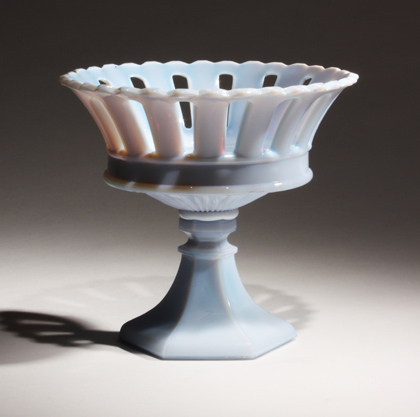Competing with porcelain?
An extremely rare opalescent fruit basket made in New England about 1840 emulates porcelain twice — in form and color — and in some ways surpasses it.

With open sides consisting of ribbons of glass it emulates a form long known in porcelain. Porcelain fruit baskets were popular in early Federal period America. They were both imported from Europe and made by America's most successful porcelain manufacturer of the period, the Tucker factory of Philadelphia.
A Tucker example in the Philadelphia Museum of Art shares this basket's basic form, with serated rim and broad lower band. While the Philadelphia example rests upon three applied paw feet, many Tucker and European baskets are fastened by metal bolts to porcelain stands. The separately pressed basket and stand of this glass example were attached by a hot glass wafer soon after they were removed from their molds.
The glass basket's color emulates the whiteness of porcelain. Not until the mid-18th Century did western ceramicists successfully emulate the intensely white glassy porcelain long imported from China. Glass manufacturers succeeded much earlier, with opaque white glass known in the ancient middle east, Renaissance Venice and from then on throughout Europe. In early 19th Century America glass emulating porcelain was sometimes called glass china. By 1829 the New England Glass Company made what they first called "enamelled glassware" but that others said resembled "the finest porcelain and pearl."
The relevant merits of porcelain and opalescent glass can be debated. Porcelain has the advantage when it comes to decoration: it can be painted with colorful glazes and refired to create long lasting, vibrant decoration. However, opalescent glass has an almost magical property: it is dichroic, changing color from bluey white in reflected light to the bright orange of flames when lit from behind.

